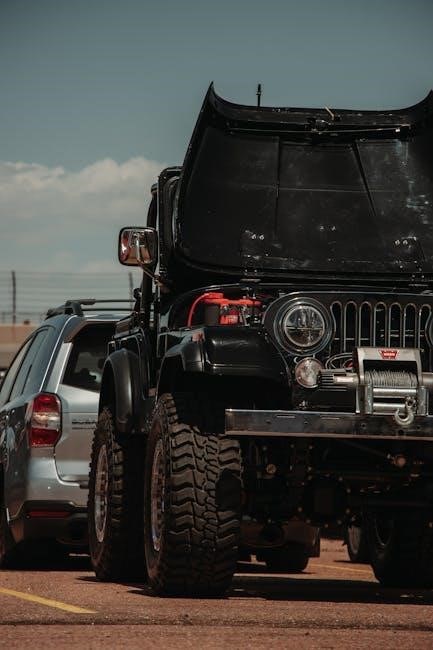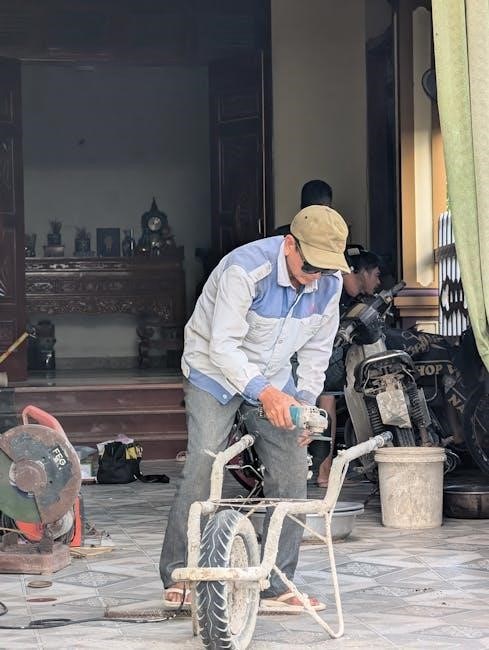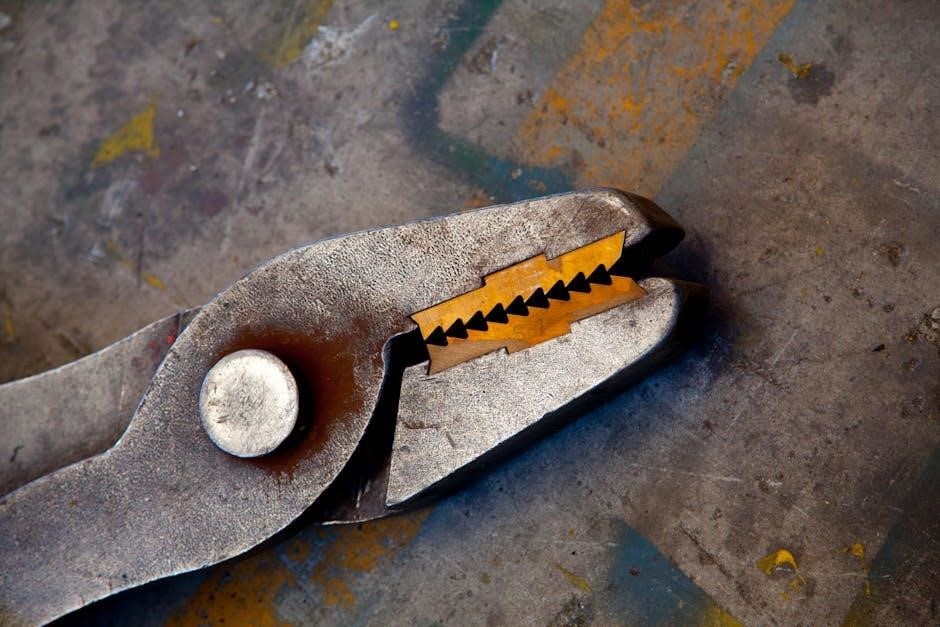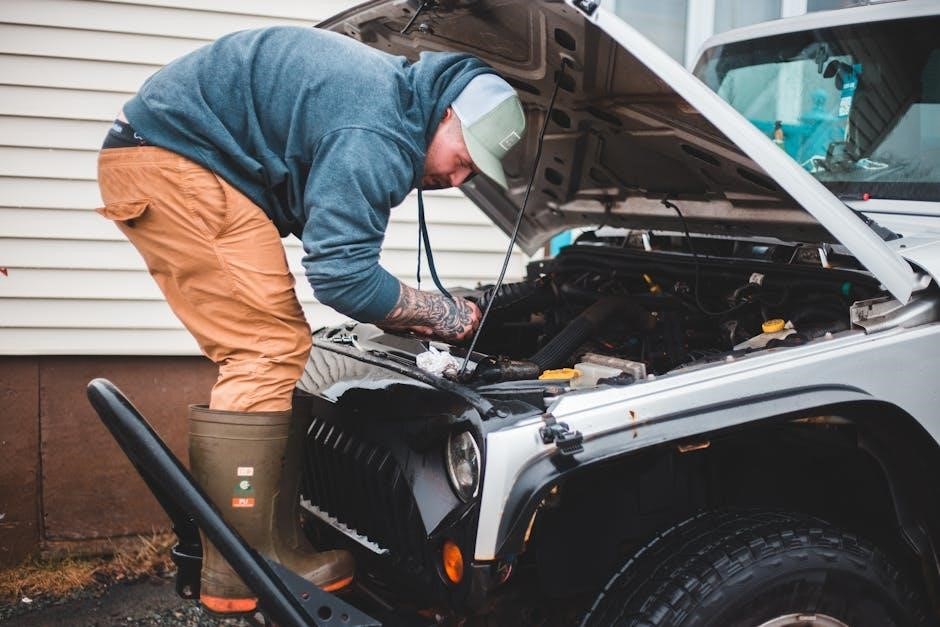The Jeep JK is a robust off-road vehicle requiring regular maintenance to ensure optimal performance. The Jeep JK maintenance schedule PDF provides a detailed guide for owners to follow recommended service intervals and procedures, ensuring longevity and reliability. Proper upkeep is essential for maintaining its durability and off-road capabilities.

1.1 What is Jeep JK?
The Jeep JK refers to the third generation of the Jeep Wrangler, produced from 2007 to 2018. It is known for its rugged design, off-road capabilities, and classic Jeep styling. The JK series includes both two-door and four-door models, offering versatility for various lifestyles. With a focus on durability and performance, the Jeep JK features a range of engine options, including 3.6L V6 and 3.8L V6 engines, paired with manual or automatic transmissions. Its four-wheel-drive system enhances traction, making it ideal for off-road adventures. The JK also introduced modern amenities while retaining the iconic Jeep look, appealing to both outdoor enthusiasts and daily drivers. Regular maintenance is crucial to uphold its performance and longevity, as outlined in the Jeep JK maintenance schedule PDF.
1.2 Importance of Regular Maintenance
Regular maintenance is essential for ensuring the longevity, performance, and safety of your Jeep JK. By adhering to the recommended Jeep JK maintenance schedule PDF, you can prevent mechanical failures, reduce repair costs, and maintain optimal functionality. Neglecting routine checks can lead to premature wear of critical components, which may result in costly damages. Regular maintenance also enhances fuel efficiency, improves handling, and ensures reliable operation, especially during off-road adventures. Additionally, it helps identify potential issues early, preventing them from escalating into major problems. A well-maintained Jeep JK not only performs better but also retains its value over time. Consistency in following the maintenance schedule is key to enjoying a trouble-free ownership experience and maximizing the vehicle’s capabilities.

Importance of Maintenance
Regular maintenance ensures the Jeep JK’s reliability, performance, and safety. It prevents breakdowns, reduces repair costs, and enhances fuel efficiency. Routine checks also extend the vehicle’s lifespan and maintain its value.
2.1 Why Regular Maintenance is Crucial
Regular maintenance is essential for ensuring the Jeep JK operates at its best. It helps prevent unexpected breakdowns, optimizes performance, and ensures safety on the road. By following the recommended schedule, owners can identify and address potential issues early, reducing the risk of costly repairs. Proper maintenance also enhances fuel efficiency, improves handling, and extends the lifespan of critical components. Additionally, regular checks ensure compliance with manufacturer guidelines, which is vital for warranty coverage. Neglecting maintenance can lead to premature wear of parts, reduced reliability, and increased risk of accidents. Consistent upkeep also maintains the vehicle’s value over time. Overall, regular maintenance is a proactive approach to safeguarding your investment and ensuring the Jeep JK remains dependable for years to come.
2.2 Consequences of Neglecting Maintenance
Neglecting regular maintenance can lead to severe consequences for your Jeep JK. Over time, critical components may degrade, resulting in mechanical failures and costly repairs. Ignoring oil changes can cause engine damage, while skipped tire rotations may lead to uneven wear and compromised handling. Brake systems left unchecked can fail, posing serious safety risks. Additionally, neglected maintenance can void warranties, leaving owners with hefty bills. Performance will decline, with reduced fuel efficiency and power output. In extreme cases, untreated issues like worn belts or hoses can cause breakdowns, stranding drivers. Consistent disregard for maintenance can also shorten the vehicle’s lifespan. Overlooking routine checks may result in catastrophic failures, endangering both the driver and passengers. Regular upkeep is vital to prevent these outcomes and ensure the Jeep JK remains reliable and safe.

Maintenance Schedule Overview
The Jeep JK maintenance schedule is organized by mileage and seasons, ensuring timely services like oil changes, tire rotations, and inspections to keep your vehicle in optimal condition.
3.1 Service Intervals by Mileage
The Jeep JK maintenance schedule outlines specific service intervals based on mileage to ensure your vehicle runs smoothly. Routine checks are recommended every 5,000 to 7,500 miles, including oil changes, tire rotations, and fluid inspections. At 15,000 to 30,000 miles, more detailed services like air filter replacements and belt inspections are advised. Major services, such as transmission fluid changes and spark plug replacements, are typically required at 60,000 to 105,000 miles. Following these intervals helps prevent mechanical failures and maintains optimal performance. The PDF guide provides a clear breakdown of what needs attention at each milestone, ensuring you never miss critical maintenance. Staying on track with these intervals is essential for extending the life of your Jeep JK and avoiding costly repairs down the road. Always consult the official manual or a certified dealership for precise recommendations tailored to your vehicle’s needs.
3.2 Seasonal Maintenance Checks
Seasonal maintenance checks are vital to ensure your Jeep JK performs optimally in varying weather conditions. For summer, inspect the air conditioning system, coolant levels, and tire pressure, as high temperatures can strain the engine and tires; In winter, check the battery health, antifreeze levels, and consider switching to winter tires for better traction. Spring is a good time to inspect belts, hoses, and wiper blades after winter wear. Fall maintenance should focus on brake systems, fluid levels, and preparing for colder months. The Jeep JK maintenance schedule PDF provides detailed seasonal checklists to help you address specific needs. Regular seasonal inspections prevent unexpected breakdowns and ensure your Jeep remains reliable year-round. Always refer to the official guide for precise recommendations tailored to your region and driving conditions.

Accessing the Jeep JK Maintenance Schedule PDF
The Jeep JK maintenance schedule PDF is a comprehensive guide available for download from official Jeep websites, authorized dealerships, or enthusiast forums, ensuring easy access for proper vehicle care.
4.1 Sources to Download the PDF
To obtain the Jeep JK maintenance schedule PDF, visit the official Jeep website or the Jeep owner’s portal, where you can log in and access the document. Local Jeep dealerships can also provide the PDF upon request. Additionally, Jeep’s official mobile apps may offer the schedule within their maintenance or owner’s manual sections. Online forums like JeepForum or Reddit communities often have users who share the PDF, and reaching out to Jeep’s customer service can also yield the document. Lastly, specialty auto parts stores or service centers may have copies available or direct you to the right source.

4.2 Understanding the PDF Content
The Jeep JK maintenance schedule PDF provides a detailed guide to keeping your vehicle in optimal condition. It outlines recommended service intervals based on mileage and usage conditions, such as normal or severe driving environments. The document includes charts or tables that break down services like oil changes, tire rotations, and filter replacements, making it easy to track when maintenance is due. Additionally, it covers seasonal checks, such as inspecting coolant levels before winter or checking tire pressure for hot weather driving. The PDF also highlights critical systems to monitor, such as brakes, belts, and batteries, and may include diagnostic tips to help identify potential issues early. By following the schedule, owners can ensure their Jeep runs efficiently, prevents costly repairs, and maintains its performance over time.
4.3 Updating the Schedule Regularly
Updating the Jeep JK maintenance schedule PDF regularly is essential to ensure you have the most accurate and up-to-date information. Jeep may release revised schedules based on new guidelines, vehicle updates, or feedback from owners and dealerships. Regular updates help you stay informed about any changes in service intervals, new maintenance requirements, or improved diagnostic procedures. Additionally, updating the schedule ensures you don’t miss critical inspections or services that could prevent breakdowns or costly repairs. Always check the official Jeep website or authorized dealerships for the latest versions of the PDF. By staying current, you can maintain your Jeep JK’s performance, reliability, and longevity, ensuring it continues to deliver the rugged capability and durability it’s known for. Regular updates are a small but important step in responsible vehicle ownership.

Key Maintenance Services
Regular maintenance ensures optimal performance and longevity. Essential services include oil changes, tire rotations, and fluid checks. These prevent mechanical issues and keep your Jeep running smoothly.
5.1 Oil Change Intervals
Regular oil changes are vital for maintaining your Jeep JK’s engine health. According to the Jeep JK maintenance schedule PDF, oil changes are recommended every 7,500 miles or 6 months under normal driving conditions. For severe driving conditions, such as frequent stop-and-go traffic, towing, or extreme temperatures, the interval is shortened to every 5,000 miles or 3 months. Using the recommended 5W-20 synthetic oil ensures optimal engine performance and longevity. Consistent oil changes prevent engine wear, improve fuel efficiency, and avoid costly repairs. Adhering to these intervals is crucial for preserving your Jeep’s durability and performance over time.
5.2 Tire Rotation and Pressure Checks
Regular tire rotation and pressure checks are essential for maintaining your Jeep JK’s performance and safety. According to the Jeep JK maintenance schedule PDF, tires should be rotated every 6,000 to 8,000 miles to ensure even tread wear and extend their lifespan. Proper tire pressure should be checked monthly and before long trips, using the levels specified in the owner’s manual or the tire information placard on the driver’s doorjamb. Underinflated tires can lead to uneven wear, reduced fuel efficiency, and increased risk of tire failure. Overinflated tires may compromise traction and handling. Consistent tire checks and rotations ensure optimal performance, safety, and longevity of your Jeep JK’s tires, especially for off-road adventures or heavy-duty use. Regular attention to tire maintenance is critical for reliability and overall vehicle health.
5.3 Air Filter Replacement
Air filter replacement is a critical part of the Jeep JK maintenance schedule to ensure optimal engine performance and fuel efficiency. The Jeep JK maintenance schedule PDF recommends replacing the air filter every 15,000 to 30,000 miles, depending on driving conditions. If you frequently drive in dusty or polluted areas, more frequent replacements may be necessary. A dirty air filter can lead to poor engine performance, reduced fuel efficiency, and potentially damage your engine over time. Always use a high-quality filter that meets Jeep’s specifications to maintain proper airflow and filtration. Refer to your Jeep JK maintenance schedule PDF for exact intervals and procedures to keep your engine running smoothly and efficiently. Regular air filter checks and replacements are essential for maintaining your vehicle’s health and performance.
5.4 Fluid Checks and Top-Ups
Regular fluid checks and top-ups are essential for maintaining the health and performance of your Jeep JK. The Jeep JK maintenance schedule PDF outlines the recommended intervals for inspecting and replenishing vital fluids, including engine oil, coolant, transmission fluid, and brake fluid. These checks should typically occur every 5,000 to 7,500 miles for oil and every 15,000 to 30,000 miles for other fluids. Always use fluids that meet Jeep’s specifications to ensure compatibility and performance. Look for signs of low fluid levels, such as dashboard warning lights or unusual temperatures, and address them promptly. Neglecting fluid maintenance can lead to overheating, reduced performance, or even engine damage. Refer to your Jeep JK maintenance schedule PDF for specific guidelines and ensure fluids are checked and topped up as needed to keep your vehicle running smoothly and efficiently.
5.5 Belt and Hose Inspections
Regular inspections of belts and hoses are critical to ensure the longevity and reliability of your Jeep JK. The Jeep JK maintenance schedule PDF recommends inspecting the serpentine belt and coolant hoses at specific intervals, typically every 15,000 to 30,000 miles. Look for signs of wear, such as cracks, frays, or excessive glazing on belts, and cracks, bulges, or leaks on hoses. Replace any components showing significant wear to prevent unexpected breakdowns. Neglecting these inspections can lead to costly repairs, such as engine damage from a snapped belt or overheating due to a failed hose. Always refer to your Jeep JK maintenance schedule PDF for exact inspection intervals and guidelines to keep your vehicle in optimal condition and avoid potential issues on the road.
5.6 Brake System Maintenance
Brake system maintenance is essential for ensuring the safety and reliability of your Jeep JK. The Jeep JK maintenance schedule PDF outlines specific intervals for inspecting and servicing brake components. Typically, brake pads and rotors should be inspected every 10,000 to 15,000 miles, while brake fluid levels should be checked during regular oil changes. Look for signs of wear, such as thinning pads, warped rotors, or leaks in brake lines. Neglecting brake maintenance can lead to reduced stopping power, increased stopping distances, or even complete brake failure. Always replace worn or damaged components promptly and bleed the brake system if air enters the lines. Adhering to the recommended schedule ensures optimal braking performance and helps prevent costly repairs down the road. Regular inspections are crucial for maintaining your Jeep JK’s safety and reliability on and off the road.
5.7 Battery Health Checks
Regular battery health checks are vital to ensure reliable starting and electrical system performance in your Jeep JK. The Jeep JK maintenance schedule PDF recommends inspecting the battery every 6 to 12 months or as specified in the document. Check the terminals for corrosion, clean them with a wire brush if necessary, and ensure all connections are tight. Look for signs of wear, such as cracks in the case or swollen sides, which indicate a failing battery. Test the battery’s charge using a multimeter or a load tester to ensure it holds a charge and has sufficient cold cranking amps. If the battery is old or shows signs of weakness, replace it promptly to avoid sudden failure. Proper maintenance extends the battery’s lifespan and prevents unexpected breakdowns, ensuring your Jeep remains dependable in all conditions.

Tools and Equipment Needed
Essential tools for Jeep JK maintenance include wrenches, screwdrivers, multimeters, and jack stands. Specialized equipment like scan tools and suspension compressors may be required for advanced tasks. Safety gear is crucial.
6.1 Essential Tools for DIY Maintenance
For DIY maintenance of your Jeep JK, essential tools include a set of metric wrenches and sockets, screwdrivers, pliers, and a multimeter for electrical checks. A tire pressure gauge is crucial for proper tire inflation. A drain pan and funnel are necessary for oil changes, while a torque wrench ensures bolts are tightened correctly. Jack stands and ramps are vital for lifting the vehicle safely. Additionally, a pair of gloves and safety goggles should always be on hand. These tools will help you perform routine tasks efficiently and safely. Regularly check and update your tool kit to ensure you’re prepared for all maintenance tasks. Always refer to your Jeep JK maintenance schedule PDF for specific tool requirements for each service.
6.2 Specialized Tools for Advanced Services
For advanced maintenance tasks on your Jeep JK, specialized tools are often required to ensure precision and safety. A scan tool or OBD-II scanner is essential for diagnosing complex issues with the vehicle’s computer systems. Suspension work may require a spring compressor, while brake bleeding necessitates a pressure bleeding kit. Engine repairs might demand a piston ring compressor or a timing light. Axle servicing could involve a bearing puller, and a transmission pan wrench is specific to transmission maintenance. These tools are typically more expensive and less commonly used but are crucial for advanced DIY projects. Always refer to your Jeep JK maintenance schedule PDF for specific tool recommendations. Investing in these specialized tools can save money in the long run by allowing you to handle complex tasks independently.

Troubleshooting Common Maintenance Issues

Identifying and addressing issues early prevents major repairs. Use diagnostic tools, consult the Jeep JK maintenance schedule PDF, and perform regular inspections to catch problems before they escalate.
7.1 Diagnosing Issues Before They Escalate
Early detection of potential issues is critical to prevent costly repairs and ensure your Jeep JK runs smoothly. Start by monitoring your vehicle’s performance, paying attention to unusual noises, warning lights, or changes in handling. Refer to the Jeep JK maintenance schedule PDF for guidance on what to look for during routine checks. Regularly inspect key components like brakes, suspension, and belts for signs of wear. Use diagnostic tools, such as OBD-II scanners, to identify trouble codes if the “Check Engine” light illuminates. Addressing problems early can save time and money, while neglecting them may lead to breakdowns or premature part failure. Always cross-reference your findings with the schedule to ensure compliance with recommended practices. This proactive approach helps maintain reliability and extends the lifespan of your Jeep JK.
7.2 Common Mistakes to Avoid in Maintenance
When following the Jeep JK maintenance schedule PDF, it’s essential to avoid common pitfalls that can compromise your vehicle’s performance. Overlooking routine checks, such as oil changes or tire pressure adjustments, can lead to premature wear. Neglecting to replace air filters or inspect belts and hoses is another frequent error, as these components are critical for engine efficiency. Using incorrect fluids or lubricants can damage systems, so always adhere to the specifications outlined in the PDF. Additionally, skipping seasonal checks or ignoring warning signs, like unusual noises or dashboard alerts, can escalate minor issues into major repairs. Avoiding these mistakes ensures your Jeep JK remains reliable and performs optimally. By following the maintenance schedule diligently, you can prevent costly breakdowns and extend the lifespan of your vehicle.
